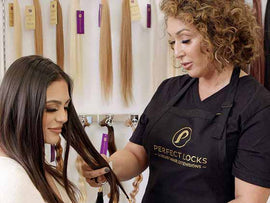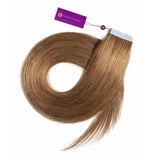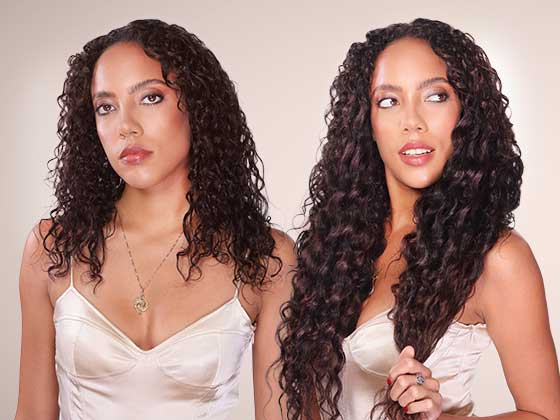Hair extensions have certainly revolutionized the beauty industry, allowing women to transform their looks and hairstyle almost instantly. Among the many options available, tape and bond extensions are popular for their ability to add length, volume, and versatility to any hairstyle.
However, deciding between tape and bond extensions requires careful consideration of various factors. Below, we will outlined the differences between tape and bond extensions to help you make an informed decision based on your preferences and lifestyle.
What are Tape Extensions?
Tape extensions are exactly as the name implies. Its application method includes attaching wefts of hair to the natural hair using adhesive tapes. This method offers several advantages that appeal to those seeking a quick and hassle-free solution for enhancing their hair.
One of the primary benefits of tape extensions is their speedy application process. Unlike traditional methods like fusion bonding or sewing, which can take several hours to complete, tape extensions can typically be applied in just a fraction of the time. This makes them ideal for individuals with busy schedules who want instant results without spending an entire day at the salon.
Tape extensions are known for their ease of maintenance. The tapes lie flat against the scalp, making them comfortable to wear and less likely to cause discomfort or irritation. Unlike other methods that involve bulky attachments or tight braids, tape extensions feel lightweight and natural, allowing you to forget that you're wearing them.
Tape extensions do have their limitations though. While they offer a seamless and natural look when properly applied, the tapes themselves can become visible if not carefully positioned. This can be a concern for individuals with fine or thin hair, as the tapes may show through, compromising the overall appearance.
Additionally, tape extensions last between six to eight weeks before needing to be repositioned or replaced. This regular maintenance requirement means that individuals who opt for tape extensions will need to schedule frequent salon appointments to ensure their extensions stay looking fresh and flawless.
What are Bond Extensions?
Bond extensions, also known as keratin or fusion extensions, offer a more permanent solution for those seeking long-lasting results. Unlike tape extensions, which adhere to the natural hair using adhesive tapes, bond extensions are attached using keratin bonds that are fused to the natural hair using heat.
One of the primary advantages of bond extensions is their durability. With proper care and maintenance, bond extensions can last up to six months or even longer, making them a cost-effective investment in the long run. This extended lifespan means that individuals who choose bond extensions can enjoy months of luxurious locks without the need for frequent touch-ups or replacements.
Bond extensions also offer unparalleled versatility in styling. Because the bonds are virtually undetectable when applied correctly, you have more freedom to experiment with different hairstyles, including updos, braids, and ponytails, without worrying about visible attachments. This makes bond extensions an excellent choice for special occasions or individuals who enjoy changing their looks regularly.
However, bond extensions do come with their own set of challenges. The application process can be more time-consuming compared to tape extensions, often requiring several hours to complete. Maintaining bond extensions requires extra care too in order to prevent the bonds from slipping or becoming tangled.
Things to Consider When Choosing
When comparing tape and bond extensions, several factors come into play, including the following:
Hair type and texture
Take into account your natural hair type and texture when choosing between tape and bond extensions. Fine or thin hair may be better suited to tape extensions, as the tapes lie flat against the scalp and are less likely to cause visible bumps. Coarse or thick hair may benefit from bond extensions, which offer a stronger bond and greater durability.
Longevity
Consider how long you want your extensions to last. Bond extensions typically have a longer lifespan than tape extensions, lasting up to six months or more with proper care. If you're looking for a more permanent solution, bond extensions may be the better choice.
Maintenance
Think about how much time and effort you're willing to invest in maintaining your extensions. Tape extensions require regular maintenance appointments every 6-8 weeks to reposition or replace the tapes. Bond extensions may require less frequent maintenance but may need extra care to prevent the bonds from slipping or becoming tangled.
Application process
Consider the time and complexity of the application process. Tape extensions can be applied relatively quickly, typically in just a few hours. Bond extensions, on the other hand, may take longer to apply due to the heat fusion process involved.
Comfort
Pay attention to how the extensions feel on your scalp and hair. Tape extensions lie flat against the scalp and feel lightweight and comfortable to wear. Bond extensions may feel slightly heavier due to the keratin bonds but should still be comfortable if applied correctly.
Styling options
Think about the versatility of styling options with each type of extension. Bond extensions offer more flexibility in styling, as the bonds are virtually undetectable and allow you to wear your hair in various styles, including updos and ponytails. Tape extensions may limit styling options due to the visibility of the tapes if you have thin hair.
Cost
Consider your budget and the overall cost of the extensions, including initial installation and maintenance appointments. While tape extensions may be more affordable upfront, the cost of regular maintenance appointments can add up over time. Bond extensions have a higher initial cost but may be more cost-effective in the long run due to their longer lifespan.
Finding Your Perfect Match
Tape and bond extensions each have their own unique advantages and considerations, making them suitable for different individuals and circumstances. No matter if you prioritize convenience, durability, or versatility, there's a hair extension method out there to suit your needs.
Before making a decision, it's essential to consult with a qualified hairstylist who can assess your hair type, lifestyle, and preferences and provide personalized recommendations.
With the right choice, you can achieve the long, luscious locks you've always dreamed of and improve your self-expression and confidence.
















